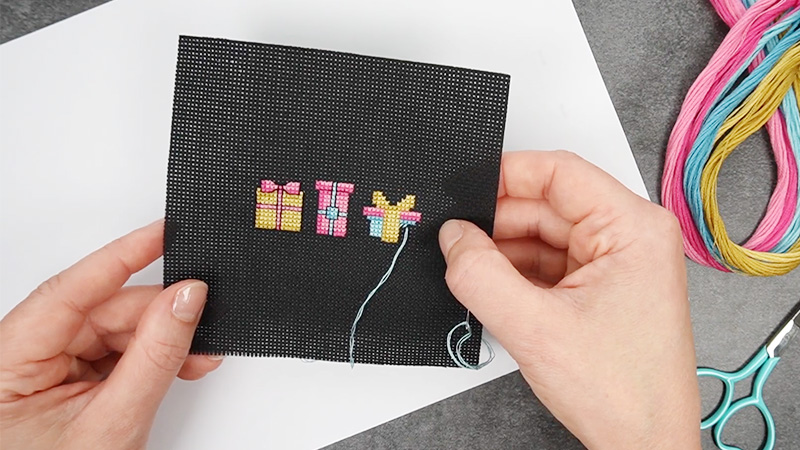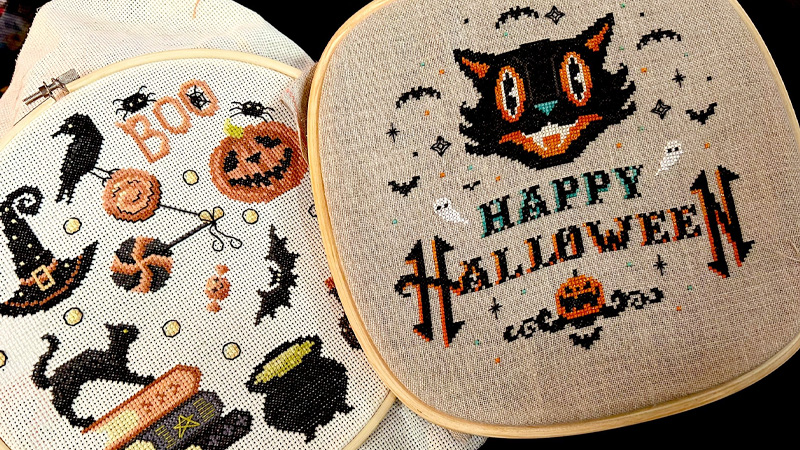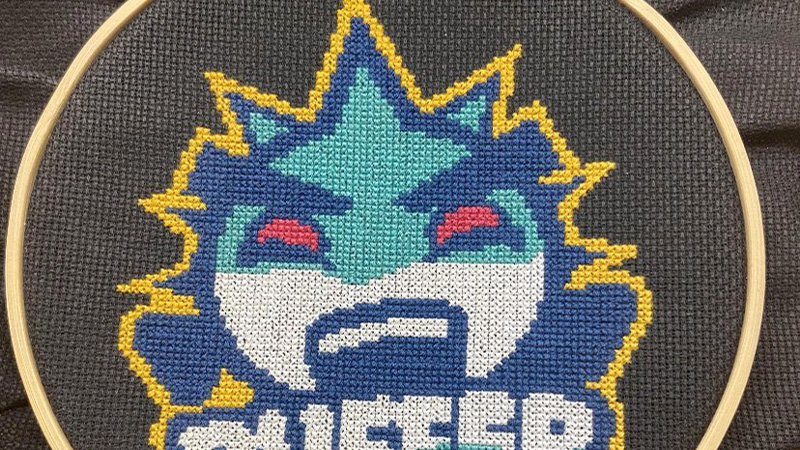Cross stitching on black linen introduces a captivating twist to this age-old craft, offering a canvas that allows vibrant colors to pop against a dramatic backdrop.
While it presents a unique set of challenges, mastering the art of cross-stitching on black linen can yield stunning results. The contrast between the dark fabric and colorful threads creates a visually striking effect that adds depth and allure to your finished piece.
In this guide, we’ll explore the how do you cross-stitch black linen. From optimizing lighting and thread choices to avoiding common pitfalls, we’ll equip you with the knowledge and skills to embark on this creative journey.
Whether you’re a novice or an experienced stitcher, working with black linen opens doors to endless creative possibilities and the satisfaction of creating exquisite works of art.

How Do You Cross-Stitch Black Linen?
Cross-stitching on black linen can be a captivating and rewarding endeavor, but it does require some adjustments to ensure your stitches show up beautifully.
Here are the simple methods for cross-stitching on black linen:
Use Bright Lighting:
Adequate lighting is crucial when working on black linen. Place a bright light source, such as a daylight lamp, directly over your stitching area to illuminate the fabric and make it easier to see your stitches.
Choose Lighter Threads:
Opt for lighter thread colors, such as white, silver, or pale pastels, for your cross stitches. These colors provide a strong contrast against the dark fabric and enhance visibility.
Use a Light-Colored Background:
Place a light-colored cloth or paper beneath your black linen while stitching. This creates a temporary background that improves the contrast, making it easier to count stitches and see your work.
Cross Stitch in Good Daylight:
Stitch during daylight hours or in well-lit rooms to maximize visibility. Natural daylight is an excellent option, as it offers the most accurate color perception.
Magnifying Tools:
Consider using magnifying tools like magnifying glasses, clip-on magnifiers, or magnifying lamps to help you see your stitches more clearly, especially if you have difficulty with fine details.
Tape or Grid Lines:
Apply low-tack masking tape or create grid lines on your black linen using a water-soluble marker. These lines can serve as visual guides for stitch placement and counting.
Work in Small Sections:
Divide your cross-stitch pattern into smaller, manageable sections. By focusing on one section at a time, you can concentrate your efforts and minimize the chances of losing your place on the dark fabric.
Cross stitching on black linen may present challenges, but with the right techniques and tools, you can create intricate and stunning designs that stand out beautifully against the dark background.
Experiment with these methods to find the combination that works best for your project and stitching preferences.
Which Fabric Is Best For Cross Stitch?

Selecting the right fabric is essential for a successful cross-stitch project. Here are seven types of fabric commonly used for cross-stitching:
Aida Cloth:
Aida cloth is a popular choice for cross-stitch beginners. It has a grid-like weave with evenly spaced holes, making it easy to count stitches and keep them uniform. Aida comes in various counts (holes per inch), with 14-count and 16-count being common options.
Evenweave Fabric:
Evenweave fabric, like linen and even weave cotton, has an even thread count both horizontally and vertically.
It provides a more refined look compared to Aida and is ideal for intricate designs. Evenweave fabrics come in various thread counts, such as 28-count or 32-count.
Linen:
Linen fabric is a natural fiber fabric with a slightly irregular weave. It offers a rustic and elegant texture to cross-stitch projects. Linen is often chosen for fine embroidery work and sampler-style designs.
Hardanger Fabric:
Hardanger fabric is specially designed for Hardanger embroidery, a type of counted thread embroidery. It typically features a crisp, open weave that allows for intricate cutwork and decorative stitches.
Lugana Fabric:
Lugana fabric is a cotton and viscose blend that combines the best qualities of Aida and even weave. It offers the ease of stitching found in Aida with the refined appearance of even weave.
Lugana is available in various thread counts, such as 25-count or 28-count.
Waste Canvas:
A Waste canvas is a temporary fabric used to stitch cross-stitch designs onto non-standard surfaces like clothing or linens.
Once the design is complete, you dampen the waste canvas and carefully pull out the threads to leave only the stitched design on the target fabric.
Monk’s Cloth:
Monk’s cloth is a popular choice for Swedish or Huck weaving embroidery, but it can also be used for cross-stitching. It has a textured appearance and is typically used for larger and bolder designs.
The choice of fabric depends on the complexity of your design, your stitching experience, and the look you want to achieve. Aida and even weave fabrics are excellent for beginners, while linen and specialty fabrics offer more versatility for experienced stitchers.
Ultimately, the best fabric for cross-stitching is the one that suits your project and personal preferences.
Common Mistakes People Make When They Cross Stitch Black Linen?

Cross-stitching on black linen can be challenging, and there are common mistakes that people often make when working with this dark fabric.
Here are the simple methods to avoid these errors:
Insufficient Lighting:
One of the most common mistakes is not having adequate lighting. Black linen absorbs light, making it crucial to have a well-lit work area. Use a bright, focused light source to ensure you can see your stitches clearly.
Using Dark Thread Colors:
Avoid using dark thread colors on black linen, as they may not stand out well. Instead, opt for lighter or contrasting thread colors to ensure your stitches are visible.
Miscounting Stitches:
Counting stitches accurately can be challenging on black fabric. Use a light-colored pencil or water-soluble marker to mark completed stitches or grid lines to help with counting. Double-check your counts frequently to prevent errors.
Knots and Tangles:
Knots and tangles can be more visible on black linen. Be mindful of your thread tension to prevent knots, and use shorter lengths of thread to reduce the risk of tangles.
Fabric Stains:
Black linen is susceptible to showing stains from oils and dirt on your hands. Wash your hands thoroughly before stitching to prevent transferring oils onto the fabric, which can be challenging to remove.
Working in Poor Light Conditions:
Avoid stitching on black linen in low light conditions, as it can strain your eyes and lead to mistakes. Stitch during daylight hours or use a daylight lamp to maintain optimal visibility.
Skipping aida or even weave for complex designs:
For intricate or complex designs, starting with Aida or even weave fabric is often easier, as black linen can make counting stitches and maintaining tension more challenging. Save black linen for projects that suit its unique look.
By being mindful of these common mistakes and taking steps to address them, you can enjoy the process of cross-stitching on black linen and achieve beautiful, error-free results in your projects.
FAQ
Can I use any cross stitch pattern on black linen, or are some patterns better suited for it?
You can use any cross-stitch pattern on black linen, but some designs with lighter colors may stand out more effectively. Consider patterns with vibrant or contrasting threads for a striking effect.
How do I choose the right thread colors for black linen?
Opt for lighter or contrasting thread colors to ensure your stitches are visible. Pastels, metallics, or bright shades work well. Test swatches can help you determine the best color combinations.
What’s the best way to count stitches on black linen?
Counting stitches on black linen can be challenging. Use a water-soluble marker to create temporary grid lines or mark completed stitches. Some stitchers find it helpful to use a lighted magnifying glass for accuracy.
Can I wash my completed cross stitch on black linen?
Yes, you can wash your finished piece on black linen, but exercise caution. Hand wash with mild detergent in cold water, and avoid vigorous rubbing. Rinse thoroughly and lay it flat to dry to prevent color bleeding or damage.
Are there any tips for preventing fabric stains while cross-stitching on black linen?
To prevent fabric stains, ensure your hands are clean and oil-free before stitching. Wash your hands thoroughly and avoid touching the fabric unnecessarily. If you notice any stains, address them promptly with gentle spot-cleaning methods to minimize damage to your project.
Conclusion
Cross-stitching on black linen is a rewarding pursuit that transforms ordinary fabric into captivating masterpieces. The tips and techniques outlined in this guide empower you to overcome the challenges presented by the dark canvas.
With careful attention to lighting, thread selection, and avoiding common mistakes, you can achieve stitches that stand out boldly against the black backdrop. The allure of cross stitching on black linen lies in the striking contrast it creates and the depth it adds to your artwork.
As you continue to hone your skills, you’ll unlock the potential to craft intricate and mesmerizing designs that capture the imagination. Embrace the uniqueness of black linen, experiment with various color combinations, and let your creativity flourish in this captivating world of cross- stitch.
Leave a Reply